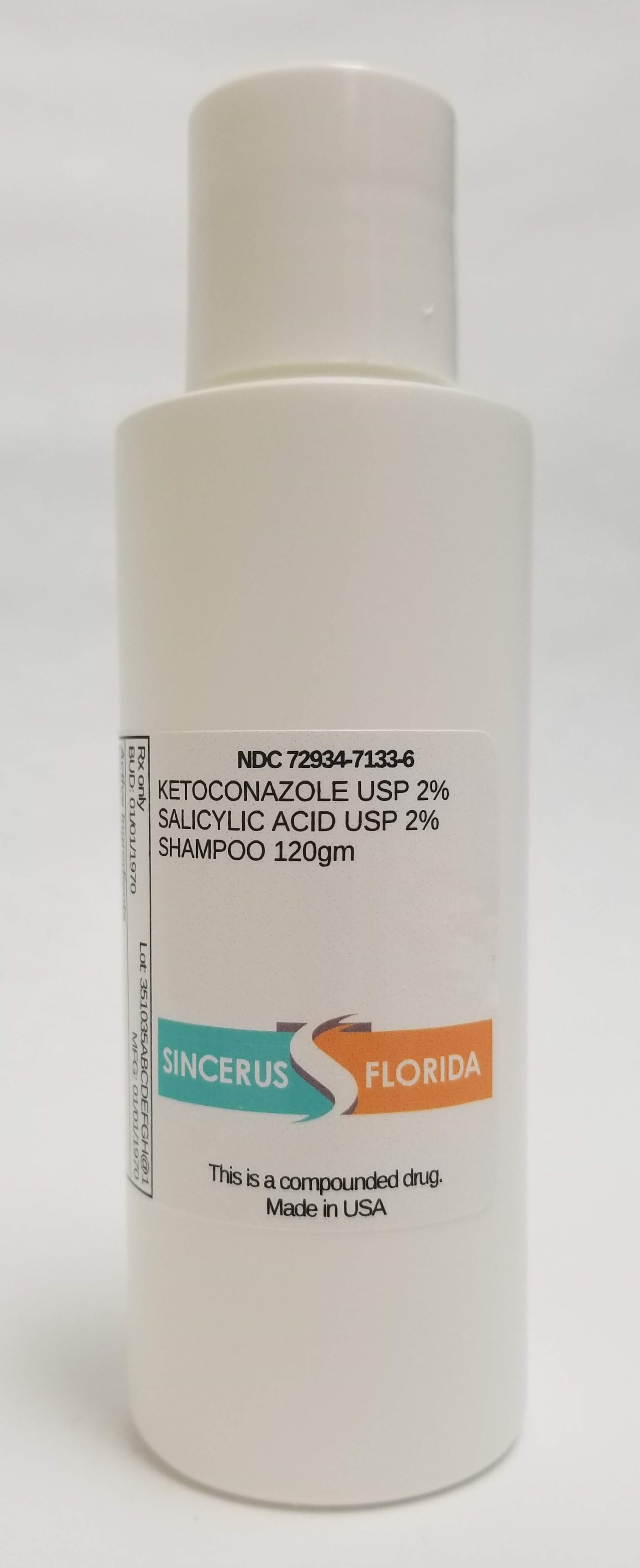Ketoconazole 2% / Salicylic Acid 2% Shampoo while Breastfeeding

I am currently breastfeeding and I want to know if using Ketoconazole 2% / Salicylic Acid 2% Shampoo is safe for my kid? Does it have any effect on milk production?

Ketoconazole 2% / Salicylic Acid 2% Shampoo Breastfeeding Analsys
Salicylic acid while Breastfeeding
SafeCAS Number: 69-72-7
It is topically used as a keratolytic, antiseptic, antifungal, dermatological and stomatological agent. At last update no published data on excretion into breast milk were found . Systemic absorption (distribution into the body) depends on the concentration of the product used and the duration of application. Absorption may reach 10 to 25% of the total amount applied on the skin. It is recommended not to use during lactation in large areas of skin or for prolonged periods. Available data on the elimination of Acetylsalicylic acid (Aspirin-ASA) in breast milk indicates it is clinically insignificant.No cases have been reported on Reye's syndrome by ASA through the breast milk which is considered very unlikely to occur with isolated and/or small doses used as antithrombotic treatments and anti-abortion measures, even less after application on the skin or topically in the mouth. Do not apply on the breast to prevent ingestion by the infant. If necessary, apply it after the feed and wipe it off thoroughly with water before the next feed.
Ketoconazole while Breastfeeding
SafeCAS Number: 65277-42-1
A high protein-binding capacity may explain its low excretion into breastmilk observed after oral administration. Low levels that would reach the infant’s gut through breastmilk would barely be absorbed due to the alkaline environment that hinders the absorption. Because it is topically used on creams or vaginal ovules, it would have a low or nil absorption in mother’s plasma (Ene 1984, AEMPS 2015), hence, the amount excreted in milk is expected to be even lower than that following a systemic administration. It would be wise to avoid applying creams, gels and other topical products containing paraffin (mineral oil) on the nipple so that the infant could not ingest it (Noti 2003, Concin 2008). American Academy of Pediatrics: medication usually compatible with breastfeeding.
Ketoconazole 2% / Salicylic Acid 2% Shampoo Breastfeeding Analsys - 2
Salicylic acid while Breastfeeding
CAS Number: 69-72-7
No information is available on the clinical use of salicylic acid on the skin during breastfeeding. Because it is unlikely to be appreciably absorbed or appear in breastmilk, it is considered safe to use during breastfeeding.[1] Avoid application to areas of the body that might come in direct contact with the infant's skin or where the drug might be ingested by the infant via licking.
Ketoconazole while Breastfeeding
CAS Number: 65277-42-1
Because there is little published experience with ketoconazole during breastfeeding and its potential liver enzyme inhibition and liver toxicity, other agents may be preferred. However, if oral ketoconazole is required by the mother, it may not be a reason to discontinue breastfeeding.[1] Taking the dose just before the infant's longest sleep period or avoiding breastfeeding from 2 to 5 hours after the dose might decrease the infant's exposure to ketoconazole. Use of ketoconazole shampoo or topical use on the skin by the mother poses little or no risk to the breastfed infant.[2][3] However, topical use on the breast or nipples should be avoided in nursing mothers because of possible oral ingestion by the infant and the availability of safer alternatives. Only water-miscible cream or gel products should be applied to the breast because ointments may expose the infant to high levels of mineral paraffins via licking.[4]
What should I do if I am breastfeeding mother and I am already exposed to Ketoconazole 2% / Salicylic Acid 2% Shampoo?
It is always a good idea to keep your healthcare provider or doctor informed about your drug usage during pregnancy and breastfeeding but if you have not informed your doctor about Ketoconazole 2% / Salicylic Acid 2% Shampoo and have used it then do not panic as Ketoconazole 2% / Salicylic Acid 2% Shampoo is mostly safe in breastfeeding and should not cause any harm to your baby.
My health care provider has asked me to use Ketoconazole 2% / Salicylic Acid 2% Shampoo, what to do?
Usage of Ketoconazole 2% / Salicylic Acid 2% Shampoo is safe for nursing mothers and baby, No worries.
If I am using Ketoconazole 2% / Salicylic Acid 2% Shampoo, will my baby need extra monitoring?
No
Who can I talk to if I have questions about usage of Ketoconazole 2% / Salicylic Acid 2% Shampoo in breastfeeding?
US
National Womens Health and Breastfeeding Helpline: 800-994-9662 (TDD 888-220-5446) 9 a.m. and 6 p.m. ET, Monday through Friday
UK
National Breastfeeding Helpline: 0300-100-0212 9.30am to 9.30pm, daily
Association of Breastfeeding Mothers: 0300-330-5453
La Leche League: 0345-120-2918
The Breastfeeding Network supporter line in Bengali and Sylheti: 0300-456-2421
National Childbirth Trust (NCT): 0300-330-0700
Australia
National Breastfeeding Helpline: 1800-686-268 24 hours a day, 7 days a week
Canada
Telehealth Ontario for breastfeeding: 1-866-797-0000 24 hours a day, 7 days a week
